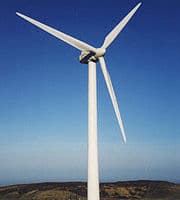
Wind Turbine Design
Wind Turbine Design for Wind Power
![]() At the heart of any renewable wind power generation system is the Wind Turbine. Wind turbine design generally comprise of a rotor, a direct current (DC) generator or an alternating current (AC) alternator which is mounted on a tower high above the ground.
At the heart of any renewable wind power generation system is the Wind Turbine. Wind turbine design generally comprise of a rotor, a direct current (DC) generator or an alternating current (AC) alternator which is mounted on a tower high above the ground.
So how are wind turbines designed to produce electricity. In its simplest terms, a wind turbine is the opposite to a house or desktop fan. The fan uses electricity from the mains grid to rotate and circulate the air, making wind.
Wind turbine designs on the other hand use the force of the wind to generate electricity. The winds movement spins or rotates the turbines blades, which captures the kinetic energy of the wind and convert this energy into a rotary motion via a shaft to drive an electrical generator and make electricity as shown.
Typical Wind Turbine Generator Design
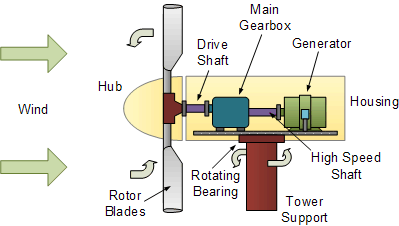
The image above shows the basic components that go to make up a typical wind turbine design. A wind turbine extracts the kinetic energy from the wind by slowing the wind down, and transferring this energy into the spinning shaft so it is important to have a good design. The available power in the wind that is available for harvesting depends on both the wind speed and the area that is swept by the rotating turbine blades.
So therefore, the faster the wind speed or the larger the rotor blades the more energy can be extracted from the wind. So we can say that wind turbine power production depends on the interaction between the rotor blades and the wind and it is this interaction that is important for a wind turbine design.
To help improve this interaction and therefore increase efficiency two types of wind turbine design are available. The common horizontal axis and the vertical axis wind turbine design. The horizontal axis wind turbine design catches more wind so the power output is higher than that of a vertical axis wind turbine design. The disadvantage of the horizontal axis design is that the tower required to support the wind turbine is much higher and the design of the rotor blades has to be much better.
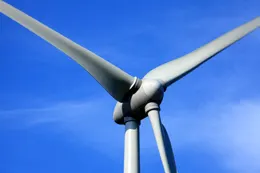
The Vertical Axis Turbine or VAWT, is easier to design and maintain but offers lower performance than the horizontal axis types due to the high drag of its simple rotor blade design. Most wind turbines generating electricity today either commercially or domestically are horizontal axis machines so it is these types of wind turbine design we will look at in this wind turbine tutorial.
The Rotor – This is the main part of a modern wind turbine design that collects the winds energy and transforms it into mechanical power in the form of rotation. The rotor consists of two or more laminated-wood, fibreglass or metal “rotor blades” and a protective hub which rotates (hence its name) around a central axis.
Just like an aeroplane wing, wind turbine blades work by generating lift due to their curved shape. The rotor blades extract part of the kinetic energy from the moving air masses according to the lift principle at a rate determined by the wind speed and the shape of the blades. The net result is a lift force perpendicular to the direction of flow of the air. Then the trick is to design the rotor blade to create the right amount of rotor blade lift and thrust producing optimum deceleration of the air and no more.
Unfortunately the turbines rotor blades do not capture 100% all of the power of the wind as to do so would mean that the air behind the turbines blades would be completely still and therefore not allow any more wind to pass through the blades. The theoretical maximum efficiency that the turbines rotor blades can extract from the wind energy amounts to between 30 and 45% and which is dependant on the following rotor blade variables: Blade Design, Blade Number, Blade Length, Blade Pitch/Angle, Blade Shape, and Blade Materials and Weight to name a few.
Blade Design – Rotor blade designs operate on either the principle of the lift or drag method for extracting energy from the flowing air masses. The lift blade design employs the same principle that enables aeroplanes, kites and birds to fly producing a lifting force which is perpendicular to the direction of motion. The rotor blade is essentially an aerofoil, or wing similar in shape to an aeroplane wing. As the blade cuts through the air, a wind speed and pressure differential is created between the upper and lower surfaces of the blade.
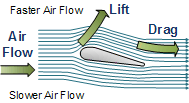
The pressure at the lower surface is greater and thus acts to “lift” the blade upwards, so we want to make this force as big as possible. When the blades are attached to a central rotational axis, like a wind turbine rotor, this lift is translated into a rotational motion.
Opposing this lifting force is a drag force which is parallel to the direction of motion and causes turbulence around the trailing edge of the blade as it cuts through the air. This turbulence has a braking effect on the blade so we want to make this drag force as small as possible. The combination of lift and drag causes the rotor to spin like a propeller.
Drag designs are used more for vertical wind turbine designs which have large cup or curved shaped blades. The wind literally pushes the blades out of the way which are attached to a central shaft. The advantages of drag designed rotor blades is slower rotational speeds and high torque capabilities making them useful for water pumping and farm machinery power. Lift powered wind turbines having a much higher rotational speed than drag types and therefore are well suited for electricity generation.
Blade Numbers – The number of rotor blades a wind turbine design has is generally determined by the aerodynamic efficiency and cost. The ideal wind turbine design would have many thin rotor blades but most horizontal axis wind turbine generators have only one, two or three rotor blades.
Increasing the number of rotor blades above three gives only a small increase in rotor efficiency but increases its cost, so more than three blades are usually not required but small high spinning multi-bladed turbine generators are available for home use. Generally, the fewer the number of blades, the less material is needed during manufacturing reducing their overall cost and complexity.
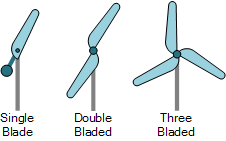
Single bladed rotors have a counter balance weight on the opposite side of the rotor but suffer from high material stress and vibration due to their unsmooth rotational motion of the single blade which must move more rapidly to capture same amount of wind energy.
Also with single or even double bladed rotors, most of the available air movement and therefore wind power passes through the unswept cross-sectional area of the turbine without interacting with the rotor decreasing their efficiency.
Multi-bladed rotors on the other hand have a smoother rotational operation and lower noise levels. Slower rotational speeds and torque are possible with multi-bladed designs which reduces the stresses in the drive train, resulting in lower gearbox and generator costs. However, wind turbine designs with many blades or very wide blades will be subject to very large forces in very strong winds which is why most wind turbine designs use three rotor blades.
An Odd or Even Number of Rotor Blades – A wind turbine design which has an “EVEN” number of rotor blades, 2, 4 or 6, etc, can suffer from stability problems when rotating. This is because each rotor blade has an exact and opposite blade which is located 180o in the opposite direction.
As the rotor rotates, the very moment the uppermost blade is pointing vertically upwards (12 o’clock position) the lower most blade is pointing straight down in front of the turbine support tower. The result is that the uppermost blade bends backwards, because it receives the maximum force from the wind, called “thrust loading”, while the lower blade passes into the wind free area directly in front of the supporting tower.
This uneven flexing of the turbines rotor blades (uppermost bent in the wind and the lowermost straight) at each vertical alignment produces unwanted forces on the rotor blades and rotor shaft as the two blades flex back and forth as they rotate. For a small rigid aluminium or steel bladed turbine this may not be a problem unlike longer fibreglass reinforced plastic blades.
A wind turbine design which has an “ODD” number of rotor blades (at least three blades) rotates smoother because the gyroscopic and flexing forces are more evenly balanced across the blades increasing the stability of the turbine.
The most common odd bladed wind turbine design is that of the three bladed turbine. The power efficiency of a three bladed rotor is slightly above that of a similar sized two bladed rotor and due to the additional blade they can rotate slower reducing wear and tear and noise.
Also, to avoid turbulence and interaction between the adjoining blades, the spacing between each blade of a multi-bladed design and its rotational speed should be big enough so that one blade will not encounter the disturbed, weaker air flow caused by the previous blade passing the same point just before it. Because of this limitation most odd type wind turbines have a maximum of three blades on their rotors and generally rotate at slower speeds.
Generally, three bladed turbine rotors integrate better into the landscape, are more aesthetically appealing and are more aerodynamically efficient than two bladed designs which contributes to the fact that three bladed wind turbines are more dominate in wind power generation market. Although certain manufacturers produce two and six-blade turbines (for sail boats).
Other advantages of odd (three) bladed rotors include smoother operation, less noise and fewer bird strikes which compensate for the disadvantage of the higher material costs. Noise level is not affected significantly by the blade count.
Rotor Blade Length – Three factors determine how much kinetic energy can be extracted from the wind by a wind turbine: “the density of the air”, “the speed of the wind” and “the area of the rotor”. The density of the air depends upon how far above sea level you are while the wind speed is controlled by the weather. However, we can control the rotational area swept by the rotor blades by increasing their length as the size of the rotor determines the amount of kinetic energy a wind turbine is able to capture from the wind.
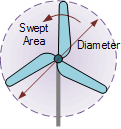
The rotor blades rotate around a central bearing forming a perfect circle of 360o as it rotates and as we know from school, the area of a circle is given as: π.r2. So as the swept area of the rotor increases, the area it covers also increases with the square of the radius. Thus, doubling the length of a turbines blades results in an increase of four times its area which allows it to receive four times as much wind energy. However, this greatly increases the size, weight and ultimately the cost of the wind turbine design.
One important aspect of the blade length is the rotational tip-speed of the rotor resulting from the angular velocity. The longer the turbine blade length the faster the rotation of the tip for a given wind speed. Likewise, for a given rotor blade length the higher the wind speed the faster the rotation.
Then why can we not have a wind turbine design with very longer rotor blades operating in a windy environment producing lots of free electricity from the wind. The answer is that there becomes a point where the length of the rotor blades and the speed velocity of the wind actually reduces the output efficiency of the turbine. This is why many larger wind turbine designs rotate at much slower speeds.
Efficiency is a function of how fast the rotor tip rotates for a given wind speed producing a constant wind speed to tip ratio called the “tip-speed ratio” ( λ ) which is a dimensionless unit used to maximise the rotor efficiency. In other words, “tip-speed ratio” (TSR) is the ratio of the speed of the rotating blade tip in rpm to the speed of the wind in kilometers-per-hour (Kph), or miles-per-hour (mph).
A good wind turbine design will determine the rotor power for any combination of wind and rotor speed. The larger this TSR ratio, the faster the rotation of the wind turbine rotor at a given wind speed. The shaft speed that the rotor is fixed too is given in revolutions per minute (rpm) and depends on the tip-speed and the diameter of the turbines blades.
A turbines rotational speed is defined as: rpm = wind speed x tip-speed-ratio x 60 / (diameter x π).
If a turbines rotor rotates too slowly, it allows too much wind to pass through undisturbed, and thus does not extract as much as energy as it could. On the other hand, if the rotor blade rotates too quickly, it appears to the wind as one large flat rotating circular disc, which creates large amounts of drag and tip losses slowing the rotor down. Therefore it is important to match the rotational speed of the turbine rotor to a particular wind speed so that the optimum efficiency is obtained.
Turbine rotors with fewer blades reach their maximum efficiency at higher tip-speed ratios and generally, three bladed wind turbine designs for electrical generation have a tip speed ratio of between 6 and 8, but will run more smoothly because they have three blades. On the other hand, turbines used for water pumping applications have a lower tip speed ratio of between 1.5 and 2 as they are specially designed for high torque generation at low speeds.
Rotor Blade Pitch/Angle – fixed design wind turbine rotor blades are generally not straight or flat like aeroplane aerofoil wings, but instead have a small twist and taper along their length from the tip to the root to allow for the different rotational speeds along the blade. This twist allows for the blade to absorb the winds energy when the wind is coming at it from different tangential angles and not just straight-on. A straight or flat rotor blade will stop giving lift and may even stop (stall), if the rotor blade is hit by the wind at different angles, called the “angle of attack” especially if this angle of attack is too steep.

Therefore, to keep the rotor blade seeing an optimum angle of attack increasing lift and efficiency, wind turbine design blades are generally twisted throughout the length of the blade. In addition, this twist in the wind turbine design keeps the rotor blades from spinning too fast in high wind speeds.
However, for very large-scale wind turbine designs used for electrical power generation, this twisting of the blades can make their construction very complicated and expensive, so some other form of aerodynamic control is used to keep the blades angle of attack perfectly aligned with the wind direction.
The aerodynamic power produced by the wind turbine can be controlled by adjusting the pitch angle of the wind turbine in relationship to the angle of attack of the wind as each blade is rotated about its longitudinal axis. Then rotor blades with pitch control can be flatter and more straight but generally these large blades have a similar twist in their geometry but much smaller to optimise the tangential loading on the rotor blade.
Each rotor blade has a rotational twist mechanism, either passive or dynamic built into the root of the blade, producing a uniform incremental pitch control along its length (constant twist). The amount of pitch required is only a few degrees as small changes in the pitch angle can have a dramatic effect on the power output as we know from the previous tutorial that the energy contained in the wind is proportional to the cube of the wind speed.
One of the major advantages of rotor blade pitch control is the increase in the wind speed window. A positive pitch angle produces a large starting torque as the rotor begins to turn decreasing its cut-in wind speed. Likewise, in high wind speeds when the rotors maximum speed limit is reached, the pitch can be controlled to keep the rotors rpm from exceeding its limit by reducing their efficiency and angle of attack.
Power regulation of a wind turbine can be achieved by using pitch control on the rotor blades to either reduce or increase the lift force on the blades by controlling the angle of attack. Smaller rotor blades achieve this by incorporating a small twist in their design.
Larger commercial wind turbines use pitch control either passive, with the aid of centrifugal springs and levers (similar to helicopter rotors) or by active using small electrical motors built into the blades hub to rotate it the required few degrees. The principal disadvantages of pitch control are reliability and cost.
Blade Construction – the kinetic energy extracted from the wind is influenced by the geometry of the rotor blades and determining the aerodynamically optimum blade shape and design is important.
But as well as the aerodynamic design of the rotor blade the structural design is equally important. The structural design consists of blade material selection and strength as the blades flex and bend by the winds energy while they rotate.
Obviously, the ideal constructional material for a rotor blade would combine the necessary structural properties of high strength to weight ratio, high fatigue life, stiffness, its natural vibration frequency and resistance to fatigue along with low cost and the ability to be easily formed into the desired aerofoil shape.
The rotor blades of smaller turbines used in residential applications that range in size from 100 watts and upwards are generally made of solid carved wood, wood laminates or wood veneer composites as well as aluminium or steel. Wooden rotor blades are strong, light weight, cheap, flexible and popular with most do-it-yourself wind turbine designs as they can be easily made. However, the low strength of wood laminates compared with other wood materials renders it unsuitable for blades with slender designs operating at high tip speeds.
Aluminium blades are also light weight, strong and easy to work with, but are more expensive, easily bent and suffer from metal fatigue. Likewise steel blades uses the cheapest material and can be formed and shaped into curved panels following the required aerofoil profile. However, it is much harder to introduce a twist into steel panels, and together with poor fatigue properties, meaning it rusts, means that steel is rarely used.
The rotor blades used for very large horizontal axis wind turbine design are made from reinforced plastic composites with the most common composites consisting of fibreglass/polyester resin, fibreglass/epoxy, fibreglass/polyester and carbon-fibre composites. Glass-fibre and carbon-fibre composites have a substantially higher compressive strength-to-weight ratio compared with the other materials. Also, fibreglass is lightweight, strong, inexpensive, has good fatigue characteristics and can be used in a variety of manufacturing processes.
The size, type and construction of the wind turbine you may need depends on your particular application and power requirements. Small wind turbine designs range in size from 20 watts to 50 kilowatts (kW) with smaller or “micro” (20- to 500-watt) turbines be used in residential locations for a variety of applications such electrical power generation for charging batteries and powering lights.
Wind energy is among the world’s fastest-growing sources of renewable energy as it is a clean, widely distributed energy resource that is abundant, has zero fuel cost, emissions-free power generation technology. Most modern wind turbine generators available today are designed to be installed and used in residential type installations.
As a result, they are manufactured smaller and more lightweight allowing them to be quickly and easily mounted directly onto a roof or onto a short pole or tower. Installing a newer turbine generator as part of your home wind power system will allow you to reduce most of the higher costs of maintaining and installing a taller and more expensive turbine tower as you would have before in the past.
In the next tutorial about Wind Energy, we will look at the operation and design of wind turbine generators used for generating electricity as part of a home based wind turbine generating system.












I will now power my homemade wind turbine with an electrical fan connect to the turbine to produce unlimited energy.
Highly informative and educative article on wind turbines.
Does anyone see value in having live datasets available from Wind Turbine sensors to aid in the development, design and forensics of new/existing turbines?
Using real operating data collected from a particular location under common conditions is always useful and will help determine the feasability and/or expected power output from a wind turbine. Sampling data can include minimum and maximum wind speed, wind direction, actual power output, etc. as datasets can take on many forms.
What year was this published?
Could you please help me to answer which the risk below are not concerning Wind parks installation
– Load alteration
– Exposure and lighting
– Creak in the rotor blades
– Fault in the erection
Thank you very much in advance
creak in the rotor blades- need greased
Thanks for the article, really need to learn about turbine design.
Quick Question.
What are the advantages/disadvantages of using front or rear mounted blades. Most have front mounted, but I have seen some, rear mounted. I would have thought rear were best, as you would then have wind assist to help point the turbine, while front mounted would have to be 100% power driven.
Fof
We are unclear by your description of front blades and rear blades, or whether you are referring to counter-rotating blades or contra-rotating blades. Clearly a front facing set of blades would receive the full force and energy of the wind while the airflow over a rear set of blades is affected by any obsticles (nacelle, hub, column, etc.) in front of the blades. Dual bladed generators are more common in tidal stream applications.
Wind turbine design and technology has been developed over several decades. The main driving factor for wind energy is the cost of energy, which is the motivation for more efficient and larger turbines.The Future of Wind Energy is bright
my company is developing a transmission that doubles the torque delivered by the rotor. Information available
Regards
Would like to know more about this!
this is awkward
when was this article written administrator ? :l
when was this article reten
When was this article written
No one tell him
Who is the author of this article?
Alternative Energy Tutorials
Who specificly wrote this article?
Alternative Energy Tutorials
tutorials for your MUM!!!!!!!!!!!!!!
yeah but like. specifically specifically who wrote it????
I have to generate 3 kW of electricity from Wind turbine. Will you please suggest me the design required for size & blades & rpm of turbine ?
i lovve physics
In VAWT design do you know if the blades rotate with the lift centripetally towards the inside or orientated such that the lift is centrifugal with respect to the center hub ?
Is there any advantage on one over the other ?
It depends on the design, VAWT can be of a Savonius drag design or a Darrieus lift design. Vertical Axis Wind Turbine
good info
easy